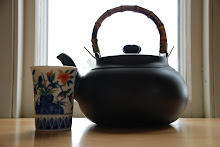
A combination of too much birthday cake (of the ice cream variety) at work and the tedium of morning rounding had me yearning for a different kind of tea. The small bag of Ba Bao Cha, alternatively known as Eight Treasures tea, in the tea cabinet beckoned; it languished unceremoniously in the nook occupied by the bagged herbal teas although the Ba Bao Cha itself has a green tea base. This tea was purchased from a Hong Kong teahouse and presented to me as a gift several months ago. From the little information I have garnered on this tea, I knew that it is comprised of eight ingredients although the roster seems to be a variable one. The transparent bag which it came in revealed a motley bunch of ingredients, many of which I was not able to identify, and the Chinese inscriptions on the plastic bag -all Greek to me- did not help to illuminate the nature of its contents.
However, after tearing the bag open along its perforation, I detected a citrus-y scent and recognized what may be some grated orange peel, two chrysanthemum buds, an unpeeled longan, variously dessicated-looking berries, many cubes of rock sugar, and of course, the green tea itself.

I decided to brew the tea in my gaiwan, wanting to fully appreciate the interplay of all the curious-looking ingredients as the tea steeped, unfettered by an infuser. Plopping only two cubes of rock sugar into the hot water (I did not want an overly sweet tasting tea), I set out to wait patiently for the five minute brewing time to elapse while our gray cat at my elbow sniffed inquisitively at the unfamiliar scents emanating from the gaiwan. And indeed, a potpourri of scents wafted by: faintly floral, the reassuringly vegetal one of the green tea, and something vaguely medicinal. I sipped the liquor gingerly; the first taste, not unpleasant. Yes, it was slightly mediciney, but it did not have the cloying sweetness of cough syrup. However, as I continued to sip the tea, I was more certain of detecting the flavor of ginseng. My olfactory memory, now triggered, I conjured up an image of myself, as a child, drinking a ginseng tisane all the while grimacing at its bitterness.

I decided to brew the tea in my gaiwan, wanting to fully appreciate the interplay of all the curious-looking ingredients as the tea steeped, unfettered by an infuser. Plopping only two cubes of rock sugar into the hot water (I did not want an overly sweet tasting tea), I set out to wait patiently for the five minute brewing time to elapse while our gray cat at my elbow sniffed inquisitively at the unfamiliar scents emanating from the gaiwan. And indeed, a potpourri of scents wafted by: faintly floral, the reassuringly vegetal one of the green tea, and something vaguely medicinal. I sipped the liquor gingerly; the first taste, not unpleasant. Yes, it was slightly mediciney, but it did not have the cloying sweetness of cough syrup. However, as I continued to sip the tea, I was more certain of detecting the flavor of ginseng. My olfactory memory, now triggered, I conjured up an image of myself, as a child, drinking a ginseng tisane all the while grimacing at its bitterness.






4 comments:
Cha Sen, the larger red berries are Chinese dates (I think the botanical name is Zizyphus spp.) and if there are smaller ones they are probably Goji berries (also known as Wolfberries or lycium). you can eat them, on their own or after steeping - they're very tasty and good for you. Goji is a great source of antioxidants, and the red dates are a nervine tonic. :)
Thanks for the info, Veri-Tea. To tell you the truth, I was a little spooked by them not knowing their identities. I think I will hold off on eating them for now:)
Can never have too much ice cream cake along with your tea! Haha, but an enjoyable entrance into the world of Eight Treasures Tea
Yes, a very intriguing tea indeed; perhaps more ice cream the next time I have the tea will make me forget about the ginseng:)
Post a Comment